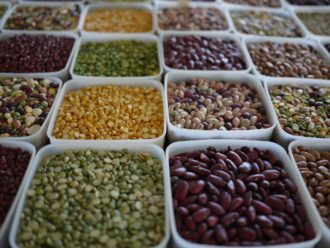When the United Nations announced that 2016 would be the “International Year of Pulses,” Craig Sheaffer wasn’t surprised. An agronomist with a bent toward organics, Sheaffer researches perennial native and introduced legumes, grasses, and woody species at the University of Minnesota (U of MN). He was well aware that pulses (also known as grain legumes), such as beans and peas, are gluten-free, high in fiber and protein, low in fat, and nutritionally a good complement to grain-based diets. He was also aware of the important role they can play in crop diversification on the farm.
“Crop diversification is the most powerful tool that farmers can use to reduce economic risk, disrupt pest cycles, and sustain soil quality,” said Sheaffer. “Soybean is the predominant grain legume in this region, but its excessive production offers little flexibility in terms of marketing. There is a critical need for more information on organic production practices for alternative grain legumes that have potential to fit our cropping systems.”
On any given day, almost 14 percent of the U.S. population eats dry edible beans, and according to the 2007 Census of Agriculture, four of the top five dry-bean producing states are located in the North Central region (Minor, 2016).
“Currently, the market for organic edible beans is often supplied by imports from other countries, despite the fact that Minnesota and North Dakota are leading edible bean producing areas in the United States,” explained Sheaffer. “This signals a market opportunity for locally grown organic legumes in the upper Midwest.”
With that in mind, Sheaffer applied for and received a $199,217 NCR-SARE Research and Education grant to bring more agronomic and marketing resources to organic, edible legumes to stimulate both the production and consumption of grain legumes. Sheaffer and his team, Tom Michaels, a bean breeder from the Department of Horticultural Sciences, and graduate students Claire Flavin and Hannah Swegarden, worked with local growers to examine the performance of several edible bean varieties, peas grown in rotation with other crops, and evaluate the effect of winter cover crops on yield and weed control in field beans. In terms of crop performance, they reported that Minnesotan organic farmers new to dry bean production should first consider reliable, stable market classes such as pinto, navy, and black to obtain stable yield and a reliable economic return. Regarding rotations, they found that either alfalfa or corn prior to dry beans is acceptable in rotations if there is adequate existing soil fertility. For producers to compare growing organic food grade and feed grade soybeans with pinto, turtle, and navy beans, they developed an “Organic Dry Bean Enterprise Budget,” a free tool for producers available online.
In conjunction with their production studies, they also worked with the Regional Sustainable Development Partnerships (RSDP) at the U of MN to analyze markets, develop crop enterprise budgets for organic edible beans, and identify marketing channels available to producers. They estimated the general size of the organic edible bean market, current sources for those edible legumes, and examined a mix of channels open to producers and growers looking to market edible legumes. The team even reached out to the U of MN’s College of Design’s surface design class to have 25 undergraduate students design images for bulk bags used to store and sell organic, locally grown dry beans.
“The market analysis suggests that small growers such as CSA or farmers market operations should grow heirloom dry beans rather than market class dry beans to differentiate their product,” said Sheaffer.
He explained that while yields can be lower, specialty products such as organic or heirloom beans can command a higher price from consumers. RSDP is currently working to help farmers set prices and deliver dry bean products into the hands of local consumers. As a result of this project, RSDP now has a full-time New Crop Market Integration Specialist to work on supply chain models for locally grown products.
“This project has spurred us to look at supply chains from a holistic perspective,” said Kathy Draeger, statewide director at RSDP. “We’re excited to be working to link the researchers, seed producers, farmers, processors, and distributors.”
